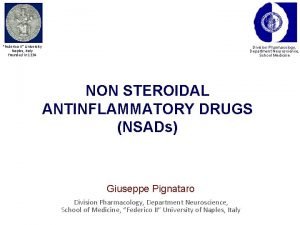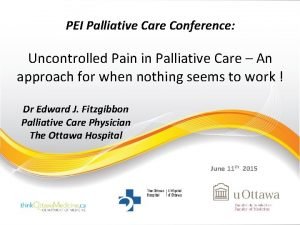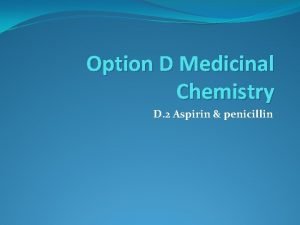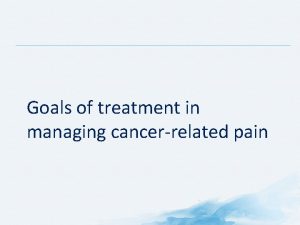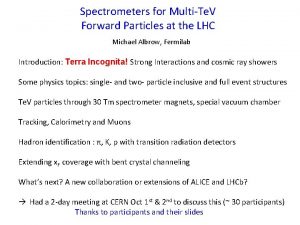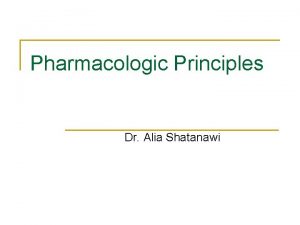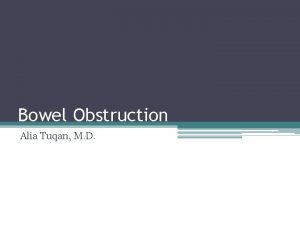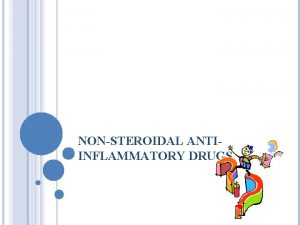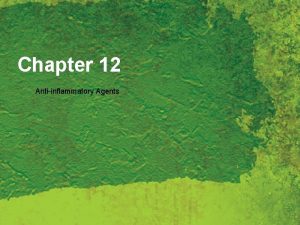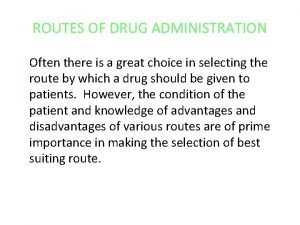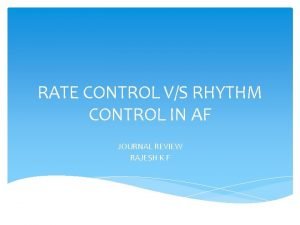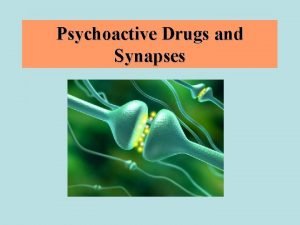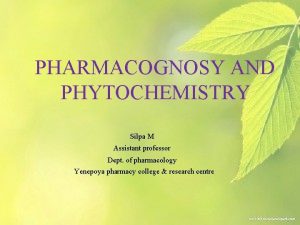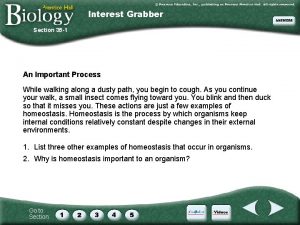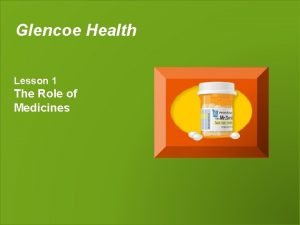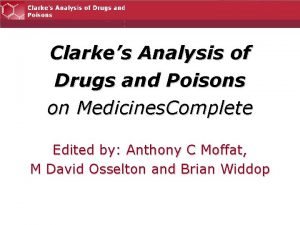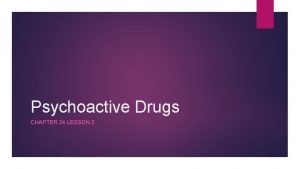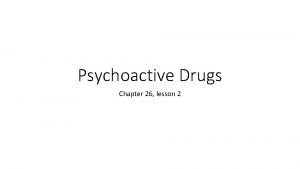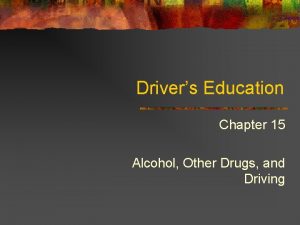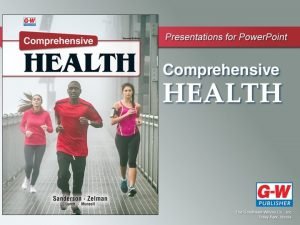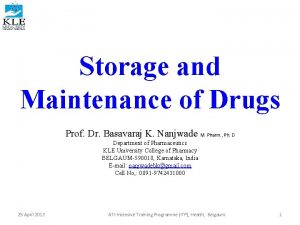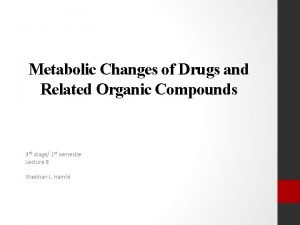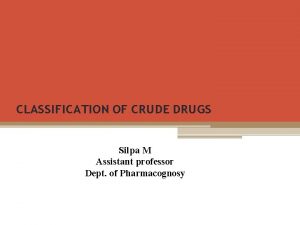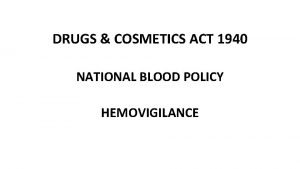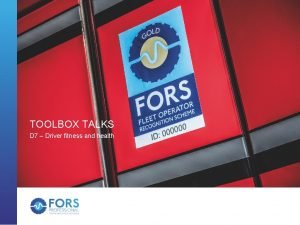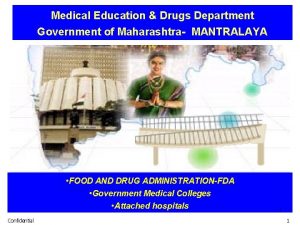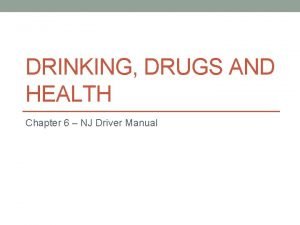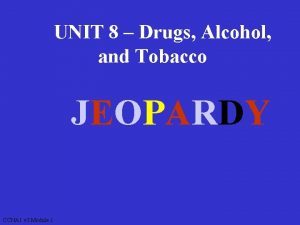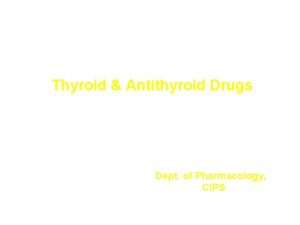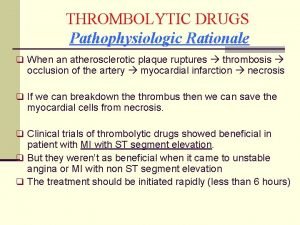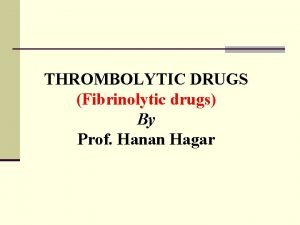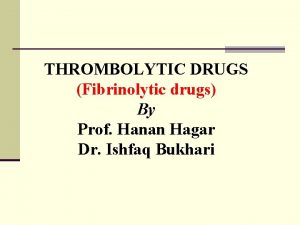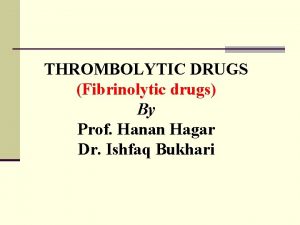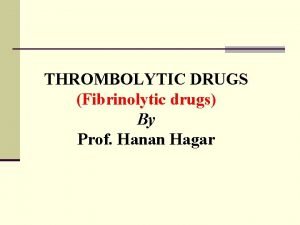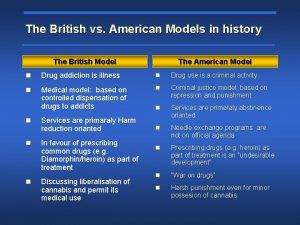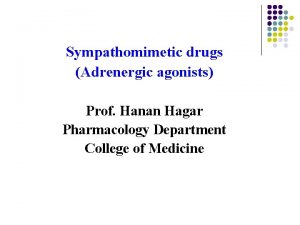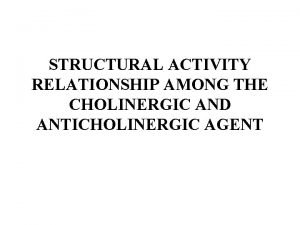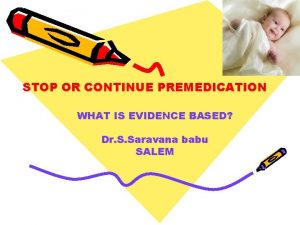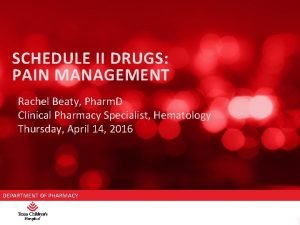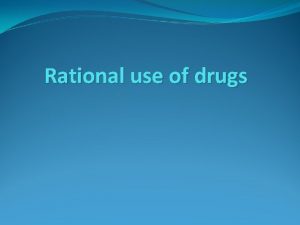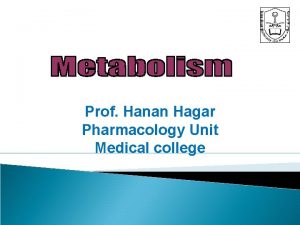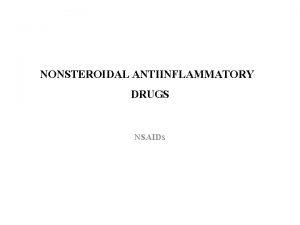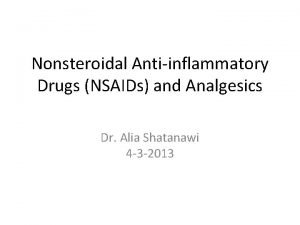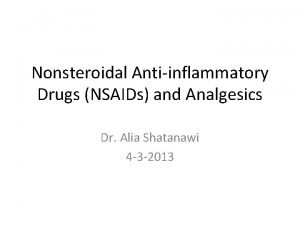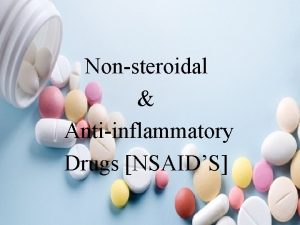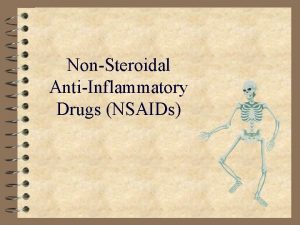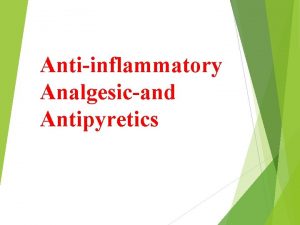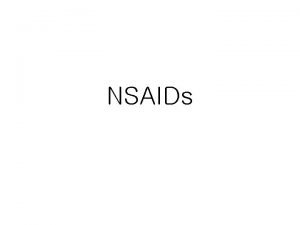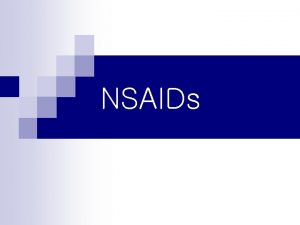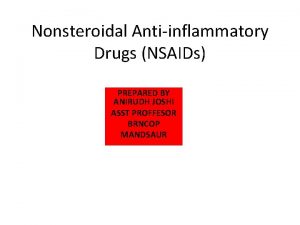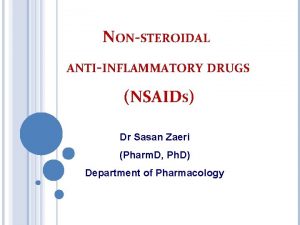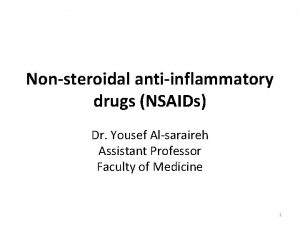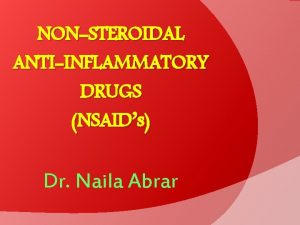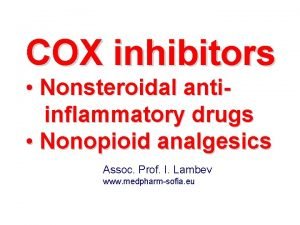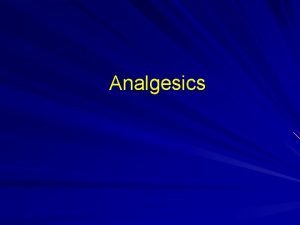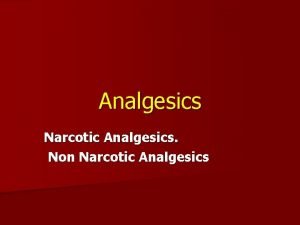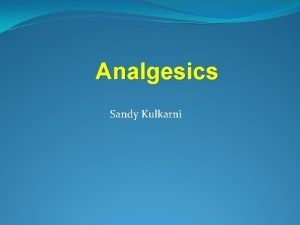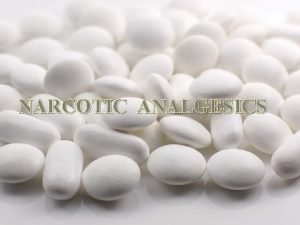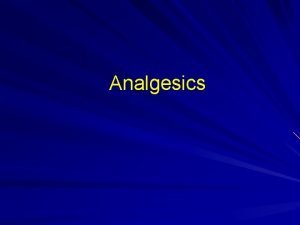Nonsteroidal Antiinflammatory Drugs NSAIDs and Analgesics Dr Alia

































































- Slides: 65

Nonsteroidal Anti-inflammatory Drugs (NSAIDs) and Analgesics Dr. Alia Shatanawi

Inflammatory pathways • Cyclooxygenase (COX) pathway of arachidonate metabolism produces prostaglandins • Effects on blood vessels, on nerve endings, and on cells involved in inflammation. • The lipoxygenase pathway of arachidonate metabolism yields leukotrienes • have a powerful chemotactic effect on eosinophils, neutrophils, and macrophages and promote bronchoconstriction and alterations in vascular permeability.




Cyclo-oxygenase (COX) • Exists in the tissue as constitutive isoform (COX-1). • At site of inflammation, cytokines stimulates the induction of the 2 nd isoform (COX-2). • Inhibition of COX-2 is thought to be due to the anti-inflammatory actions of NSAIDs. • Inhibition of COX-1 is responsible for their GIT toxicity. • Most currently used NSAIDs are somewhat selective for COX-1, but selective COX-2 inhibitors are available.

Comparison of Analgesics Feature Narcotic (Opioids) Nonnarcotic (nonopioid) Efficacy Strong Weak Prototype Morphine Aspirin Pain Relieved Any Type Musculoskeletal Site of Action Central Peripheral and Central Mechanism Specific Receptors PG Synthesis Danger Tolerance & Dependence G. I irritation Anti-inflammatory No Yes Antipyretic No Yes Antiplatelets No Yes 8

Pain - Universal, Complex, Subjective experience - No. 1 Reason people take medications - Generally is related to some type of tissue damage and serves as a warning signal

9 Munir Gharaibeh

Analgesics -Pain killers - Derived from Greek an- "without" & -algia "pain". An analgesic, or painkiller, is any member of the group of drugs used to achieve analgesia — relief from pain. - Act in various ways on the peripheral and central nervous systems.

Analgesics ▪ The non-steroidal anti-inflammatory drugs (NSAIDs) ▪ Paracetamol = acetaminophen ▪ Opioid drugs

NSAIDs • The NSAIDs are a group of chemically dissimilar agents that differ in their antipyretic, analgesic, and anti-inflammatory activities. • inhibiting the cyclooxygenase enzymes that catalyze the first step in prostanoid biosynthesis. >>>> decreased prostaglandin synthesis with both beneficial and unwanted effects.

Non-steroidal anti-inflammatory drugs (NSAIDs) pain fever Inflammation By inhibition of cyclo-oxygenase enzymes COX 1 & COX 2.

NSAIDs An anti-inflammatory action: (1) decrease Vasodilator PG (PGE 2, PGI 2) leads to less vasodilatation and, indirectly, less edema. (2) The inhibition of activity of adhesion molecule. (3) Accumulation of inflammatory cells is also reduced.

NSAIDs An analgesic effect: ▪ Decreased prostaglandin generation means decrese sensitivty of nociceptive nerve endings to inflammatory mediators. ▪ Relief of headache is due to decreased prostaglandinmediated vasodilatation.

NSAIDs An antipyretic effect: this is partly due to a decrease in the mediator prostaglandin that is responsible for elevating the hypothalamic set-point for temperature control in fever.

Mechanisms of Action Antipyretic actions – Fever, incr T° are hypothalamic problems. - So, NSAIDs do not decr body T°. - Fever release of endog pyrogens (e. g. , interleukin-1) released from leucocytes acts directly on thermoregulatory centers in hypothalamus incr body T°. - This is assoc with incr in brain PGs (pyrogenic). - Aspirin prevents the T°-rising effects of interleukin 1 by preventing the incr in brain PGs.

Pharmacological Effects (cont’d) • Diverse group of chemicals, but all inhibit cyclooxygenase. • Resultant inhibition of PG synthesis is largely responsible for their therapeutic effects. • But, inhibition of PG synthase in gastric mucosa GIT damage (dyspepsia, gastritis).

NSAID Mechanism of Action: • Inhibition of PG synthesis – Cyclooxygenase (COX) Enzyme: • COX-1 or Constitutional form of COX. • COX-2 or Induced form of COX. 13


Cardiovascular • Platelets: Inhibition of platelet COX-1 -derived Tx. A 2 with the net effect of increasing bleeding time (inhibition of platelet aggregation) • Endothelial COX-2 derived PGI 2 can inhibit platelet aggregation (inhibition augments aggregation by Tx. A 2). Aspirin (acetylsalicylic acid) covalently modifies and, irreversibly inhibits platelet COX. The enzyme is inhibited for the lifetime of the platelet (~8 -11 days). Effect achieved at very low dose. • Basis of therapeutic efficacy in stroke and MI (reduces mortality and prevents recurrent events).

Additional Cardiovascular Considerations • Blood vessels/smooth muscle COX-2 derived PGI 2 can antagonize catecholamine- and angiotensin II-induced vasoconstriction (NSAIDs can elevate bp). • Atherosclerosis Inhibition of COX-2 can destabilize atherosclerotic plaques (due to its antiinflammatory actions)

Renal • COX-1 and COX-2 – generated PGs (Tx. A 2, PGF 2 , PGI 2 (glom), PGE 2 (medulla), powerful vasodilators). • NSAIDs tend to promote Na+ retention and can therefore increase bp. Can counteract effects of many anti-hypertensives (diuretics, ACE inhibitors and -AR antagonists). • PGs have minimal impact on normal renal blood flow, but become important in the compromised kidney. • Patients (particularly elderly and volume depleted) are at risk of renal ischemia with NSAIDs.

Gastrointestinal • PGs (generated via COX-1) 1) inhibit stomach acid secretion, 2) stimulate mucus and HCO 3 - secretion, vasodilation and therefore, 3) are cytoprotective for the gastric mucosa. • Therefore, NSAIDs with COX-1 inhibitory activity will produce opposite effects, leading to: • Gastric distress, gastric bleeding, sudden acute hemorrhage (effects are dose-dependent)

Gestation PGs (generated from COX-2) are involved in the initiation and progression of labor and delivery. Therefore, inhibition of their production by NSAIDs can prolong gestation. Respiratory system High doses (salicylates) cause partial uncoupling of oxidative phosphorylation with increased CO 2 production (COX-independent effects). Increase in plasma CO 2 hyperventilation. Even higher doses cause depression of respiration.

Common Adverse Effects • Platelet Dysfunction • Gastritis and peptic ulceration with bleeding (inhibition of PG + other effects) • Acute Renal Failure in susceptible • Sodium+ water retention and edema • Analgesic nephropathy • Prolongation of gestation and inhibition of labor. • GIT bleeding and perforation

Aspirin ▪ It can cause irreversible inactivation of COX-1 and COX-2. • Aspirin is the prototype of traditional NSAIDs and was officially approved by the FDA in 1939.

Mechanism of action • Aspirin is a weak organic acid that is unique among the NSAIDs in that it irreversibly inactivates cyclooxygenase • The other NSAIDs are all reversible • Aspirin is rapidly deacetylated by esterases in the body producing salicylate, which has anti-inflammatory, antipyretic, and analgesic effects.

• The antipyretic and anti-inflammatory effects of salicylate are due primarily to the blockade of prostaglandin synthesis at thermoregulatory centers in the hypothalamus and at peripheral target sites. • Furthermore, by decreasing prostaglandin synthesis, salicylate also prevents the sensitization of pain receptors to both mechanical and chemical stimuli. • Aspirin may also depress pain stimuli at subcortical sites

ACTIONS • The NSAIDs, including aspirin, have three major therapeutic actions , they reduce • inflammation (anti-inflammation), pain (analgesia), and fever (antipyretic)

Anti-inflammatory actions: • Because aspirin inhibits cyclooxygenase activity, it diminishes the formation of prostaglandins and, thus, modulates those aspects of inflammation in which prostaglandins act as mediators. • Aspirin inhibits inflammation in arthritis, but it neither arrests the progress of the disease nor induces remission.

Analgesic action: • Prostaglandin E 2 (PGE 2) is thought to sensitize nerve endings to the action of bradykinin, histamine, and other chemical mediators released locally by the inflammatory process. • management of pain of low to moderate intensity arising from musculoskeletal disorders rather than that arising from the viscera.

Antipyretic action: • Fever occurs when the set-point of the anterior hypothalamic thermoregulatory center is elevated • > impeding PGE 2 synthesis and release > resets the hypothalamus toward normal • it rapidly lowers the body temperature of febrile patients by increasing heat dissipation as a result of peripheral vasodilation and sweating. • Aspirin has no effect on normal body temperature.

Respiratory actions: • At therapeutic doses, aspirin increases alveolar ventilation. uncouple oxidative phosphorylation, which leads to elevated CO 2 and increased respiration. • Higher doses work directly on the respiratory center in the medulla, resulting in hyperventilation and respiratory alkalosis • At toxic levels, central respiratory paralysis >> acidosis

Gastrointestinal effects: • PGE 2 stimulate synthesis of protective mucus in both the stomach and small intestine. • In the presence of aspirin, these prostanoids are not formed, resulting in increased gastric acid secretion and diminished mucus protection. • Agents used for the prevention of gastric and/or duodenal ulcers include proton-pump inhibitors (PPIs); esomeprazole, lansoprazole, omeprazol

Effect on platelets: • TXA 2 enhances platelet aggregation >> Low doses 81 mg daily of aspirin can irreversibly inhibit thromboxane production in platelets via inhibition of cyclooxygenase. • Because platelets lack nuclei, they cannot synthesize new enzyme, and the lack of thromboxane persists for the lifetime of the platelet (7 days)>> As a result prolonged bleeding time.

Actions on the kidney: • Cyclooxygenase inhibitors prevent the synthesis of PGE 2 and PGI 2 that are responsible for maintaining renal blood flow. • Decreased synthesis of prostaglandins can result in retention of sodium and water and may cause edema and hyperkalemia in some patients. • Interstitial nephritis can also occur with all NSAIDs except aspirin

Therapeutic uses Anti-inflammatory, antipyretic, and analgesic uses: • The salicylic acid derivatives are used in the treatment of gout, rheumatic fever, osteoarthritis, and RA. • Commonly treated conditions requiring analgesia include headache, arthralgia, and myalgia. External applications: • Salicylic acid is used topically to treat corns and warts.

Cardiovascular applications: • Aspirin is used to inhibit platelet aggregation. Low doses are used prophylactically to 1) reduce the risk of recurring transient ischemic attacks (TIAs) and stroke or death 2) reduce the risk of death in those having an acute myocardial infarction. , , , angina

pharmacokinetics Administration and distribution: • After oral administration, the un-ionized salicylates are passively absorbed from the stomach and the small intestine • Rectal absorption of the salicylates is slow and unreliable, but it is a useful route for administration to vomiting children. • Salicylates must be avoided in children and teenagers (<15 years old) with varicella (chickenpox) or influenza to prevent Reye's syndrome.

Dosage: • The salicylates exhibit analgesic activity at low doses; only at higher doses do these drugs show anti-inflammatory activity. • For example, two 325 -mg aspirin tablets administered four times daily produce analgesia, whereas higher dose produce both analgesic and anti-inflammatory activity. • For long-term myocardial infarction prophylaxis, the dose is 81 to 162 mg/day • for those with RA or osteoarthritis, the initial dose is 3 grams/day • for stroke prophylaxis, the dose is 50 to 325 mg/day

Fate: • At dosages of 650 mg/day, aspirin is hydrolyzed to salicylate and acetic acid by esterases in tissues and blood. • Salicylate is converted by the liver to water-soluble conjugates that are rapidly cleared by the kidney • Both hepatic and renal function should be monitored periodically in those receiving long-term, high-dose aspirin therapy. • aspirin should be avoided in patients with a creatinine clearance of less than 10 m. L/min.

Adverse effects Gastrointestinal: • The most common GI effects of the salicylates are epigastric distress, nausea, and vomiting. • Microscopic GI bleeding is almost universal in patients treated with salicylates. • At stomach p. H, aspirin is uncharged; consequently, it readily crosses into mucosal cells, where it ionizes (becomes negatively charged) and becomes trapped, thus potentially causing direct damage to the cells.

Blood: • inhibition of platelet aggregation and a prolonged bleeding time. (1 week) Respiration: • In toxic doses, salicylates cause respiratory depression and a combination of uncompensated respiratory and metabolic acidosis. Metabolic processes: • Large doses of salicylates uncouple oxidative phosphorylation. The energy normally used for the production of adenosine triphosphate is dissipated as heat, which explains the hyperthermia caused by salicylates when taken in toxic quantities

Hypersensitivity: Approximately 15 percent of patients taking aspirin experience hypersensitivity reactions. • Symptoms of true allergy include urticaria, bronchoconstriction, or angioedema. Fatal anaphylactic shock is rare. Reye's syndrome: • Aspirin and other salicylates given during viral infections has been associated with an increased incidence of Reye's syndrome, which is an often fatal, fulminating hepatitis with cerebral edema. • This is especially encountered in children, who therefore should be given acetaminophen instead of aspirin

Reye's syndrome • Reye's syndrome is a potentially fatal disease that has numerous detrimental effects to many organs, especially the brain and liver, as well as causing a lower than usual level of blood sugar (hypoglycemia). [1] The classic features are a rash, vomiting, and liver damage. The exact cause is unknown and, while it has been associated with aspirin consumption by children with viral illness, it also occurs in the absence of aspirin use.

• Drug interactions: • Salicylate is 90 to 95 percent protein bound and can be displaced from its protein-binding sites, resulting in increased concentration of free salicylate • alternatively, aspirin could displace other highly protein-bound drugs, such as warfarin, phenytoin, or valproic acid, resulting in higher free concentrations of the other agent. • Concomitant use of ketorolac and aspirin is contraindicated because of increased risk of GI bleeding and platelet aggregation inhibition.

• In pregnancy: Aspirin is classified as FDA pregnancy category C risk during Trimesters 1 and 2 • category D during Trimester 3. • Because salicylates are excreted in breast milk, aspirin should be avoided during pregnancy and while breastfeeding.

Toxicity: • The mild form is called salicylism • nausea, vomiting, marked hyperventilation, headache, mental confusion, dizziness, and tinnitus (ringing or roaring in the ears). • Ingestion of as little as 10 g of aspirin cause death in children. • In serious cases, mandatory measures include the intravenous administration of fluid, dialysis • correction of acid-base and electrolyte balances.

Propionic acid derivatives • Ibuprofen , naproxen, fenoprofe, ketoprofen , flurbiprofen • All these drugs possess anti-inflammatory, analgesic, and antipyretic activity • their GI effects are generally less intense than those of aspirin. • These drugs are reversible inhibitors of the cyclooxygenases • All are well absorbed on oral administration and are almost totally bound to serum albumin. • They undergo hepatic metabolism and are excreted by the kidney. • The most common adverse effects are GI, ranging from dyspepsia to bleeding. • Side effects involving the central nervous system (CNS), such as headache, tinnitus, and dizziness, have also been reported.

Naproxen and Ibuprofen • Pregnancy : category C, category D from • Increase the risk of cardiovascular thrombotic event, MI and stroke. • Increase risk of GI bleeding. • Ibuprofen not exceed 3200 mg/day. , and take with food or with water to avoid GI effect.

Acetic acid derivatives • indomethacin , sulindac , Etodolac • All have anti-inflammatory, analgesic, and antipyretic activity. They act by reversibly inhibiting cyclooxygenase. • Despite its potency as an anti-inflammatory agent, the toxicity of indomethacin limits use to the treatment of acute gouty arthritis, ankylosing spondylitis. • The adverse reactions caused by sulindac are similar to, but less severe than, those of the other NSAIDs, including indomethacin. • Etodolac has effects similar to those of the other NSAIDs

Oxicam derivatives • Piroxicam and meloxicam • are used to treat RA, ankylosing spondylitis, and osteoarthritis. • They have long half-lives, which permit once-daily administration, and the parent drug as well as its metabolites are renally excreted in the urine. • Meloxicam inhibits both COX-1 and COX-2, with preferential binding for COX-2, and at low to moderate doses shows less GI irritation than piroxicam.

Fenamates • Mefenamic • have no advantages over other NSAIDs as antiinflammatory agents. • Their side effects, such as diarrhea, can be severe, and they are associated with inflammation of the bowel. • Cases of hemolytic anemia have been reported

Heteroaryl acetic acids • Diclofenac and tolmetin , ketorlac • are approved for long-term use in the treatment of RA, osteoarthritis. • Diclofenac is more potent than indomethacin or naproxen. • An ophthalmic preparation is also available. • Diclofenac accumulates in synovial fluid, and the primary route of excretion for the drug and its metabolites is the kidney.

Diclofenac sodium • Used PO 50 mg after food, I. M. inj 75 mg • Diclofenac potassium is prompt release and has quicker onset where as the Diclofenac sodium is delayed release. • Pregnancy: category C • Toxicity similar to others

Acetaminophen • Acetaminophen inhibits prostaglandin synthesis in the CNS. • This explains its antipyretic and analgesic properties. • Acetaminophen has less effect on cyclooxygenase in peripheral tissues, which accounts for its weak antiinflammatory activity. • Acetaminophen does not affect platelet function or increase blood clotting time.

Therapeutic uses • Acetaminophen is a suitable substitute for the analgesic and antipyretic effects of aspirin for those patients with gastric complaints, those in whom prolongation of bleeding time would be a disadvantage, or those who do not require the anti-inflammatory action of aspirin. • Acetaminophen is the analgesic/antipyretic of choice for children with viral infections or chickenpox (recall that aspirin increases the risk of Reye's syndrome).

Adverse effects • With normal therapeutic doses, acetaminophen is virtually free of any significant adverse effects. • Renal tubular necrosis and hypoglycemic coma are rare complications of prolonged, large-dose therapy. • large doses Hepatic necrosis, a very serious and potentially lifethreatening condition can result. • Renal tubular necrosis may also occur. • Periodic monitoring of liver enzymes tests is recommended for those on high-dose acetaminophen.

Paracetamol = Acetaminophen • Weak PG synthesis inhibitor • CNS actions: Paracetamol also modulates the endogenous cannabinoid system • Not: – – antiinflammatory Platelets inhibitor Ulcerogenic Teratogenic 27

Pharmacokinetics • Acetaminophen is rapidly absorbed from the GI tract. A significant first-pass metabolism occurs in the luminal cells of the intestine and in the hepatocytes. • Under normal circumstances, acetaminophen is conjugated in the liver to form inactive metabolites. • A portion of acetaminophen is hydroxylated to form Nacetylbenzoiminoquinone a highly reactive and potentially dangerous metabolite.

• At normal doses of acetaminophen, the Nacetylbenzoiminoquinone reacts with the sulfhydryl group of glutathione, forming a nontoxic substance. • Acetaminophen and its metabolites are excreted in the urine.

Paracetamol • Toxicity – Severe hepatotoxicity with high doses – N- acetylcysteine is the antidote when given in the first 24 hours. 28

Cyclooxygenase II Inhibitors • Meloxicam • Rofecoxib • Celocoxib 34

Cyclooxygenase II Inhibitors • Do not affect platelet function. • May increase the incidence of edema and hypertension. • Less gastroirritant (half of COX 2 -non selective drugs). • Higher incidence of cardiovascular thrombotic events. 35
 Chapter 44 antiinflammatory and antigout drugs
Chapter 44 antiinflammatory and antigout drugs Acetic acid derivatives
Acetic acid derivatives Mechanism of action of opioid analgesics
Mechanism of action of opioid analgesics Classification of analgesic
Classification of analgesic Liquid gabapentin for cats dosage chart
Liquid gabapentin for cats dosage chart Gastritis x ray
Gastritis x ray Nsaids examples
Nsaids examples Radio idea
Radio idea Nur alia file upload
Nur alia file upload Alia
Alia Alia tuqan
Alia tuqan Multiteh
Multiteh What is pharmacology
What is pharmacology Alia tuqan
Alia tuqan Alia atlas
Alia atlas Git
Git Alia shatanawi
Alia shatanawi Alia shatanawi
Alia shatanawi Alia shatanawi
Alia shatanawi Remains poem message
Remains poem message Intradermal drug administration
Intradermal drug administration Rate and rhythm control drugs
Rate and rhythm control drugs Neurotransmitters and drugs
Neurotransmitters and drugs Organised and unorganised drugs difference
Organised and unorganised drugs difference Section 35-5 drugs and the nervous system answer key
Section 35-5 drugs and the nervous system answer key Rate and rhythm control drugs
Rate and rhythm control drugs Drug glencoe
Drug glencoe Drinking black coffee drivers ed
Drinking black coffee drivers ed Clarke's analysis of drugs and poisons
Clarke's analysis of drugs and poisons Drugs and alcohol toolbox talk
Drugs and alcohol toolbox talk His blood shadow stays on the street
His blood shadow stays on the street Drugs that alter moods thoughts and sense perceptions
Drugs that alter moods thoughts and sense perceptions You must put all chemicals and drugs in locked cupboards
You must put all chemicals and drugs in locked cupboards Psychedelic drugs that distort perceptions and evoke
Psychedelic drugs that distort perceptions and evoke Drug that alters moods, thoughts, and sense perceptions
Drug that alters moods, thoughts, and sense perceptions First pass effect in pharmacology
First pass effect in pharmacology Chapter 15 alcohol other drugs and driving
Chapter 15 alcohol other drugs and driving Chemistry food and drugs
Chemistry food and drugs Chapter 11 medications and drugs
Chapter 11 medications and drugs Storage and maintenance of drugs
Storage and maintenance of drugs Metabolic changes of drugs and related organic compounds
Metabolic changes of drugs and related organic compounds светр
светр Unorganised drugs examples
Unorganised drugs examples Chapter 15 alcohol other drugs and driving
Chapter 15 alcohol other drugs and driving Blood bank regulation under drugs and cosmetics act
Blood bank regulation under drugs and cosmetics act Drivers training toolbox
Drivers training toolbox Medical education and drugs department
Medical education and drugs department Chapter 6 drinking drugs and health
Chapter 6 drinking drugs and health Alcohol and other drugs
Alcohol and other drugs Drug and alcohol jeopardy
Drug and alcohol jeopardy Schedule 1 drugs
Schedule 1 drugs Antithyroid drugs classification
Antithyroid drugs classification Fibrinolytic drugs classification
Fibrinolytic drugs classification Fibrinolytic drugs
Fibrinolytic drugs Thrombolytic drugs
Thrombolytic drugs Thrombolytic drugs mechanism of action
Thrombolytic drugs mechanism of action Thrombolytic drugs
Thrombolytic drugs British model involved with drugs
British model involved with drugs Sympathomimetic agents
Sympathomimetic agents Pilocaripine
Pilocaripine Premedication drugs list
Premedication drugs list Section 17-3 note taking guide answer key
Section 17-3 note taking guide answer key Fentanyl buccal
Fentanyl buccal Ion trapping
Ion trapping Importance of rational drug use
Importance of rational drug use Factors affecting drug metabolism
Factors affecting drug metabolism

